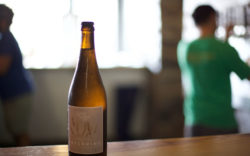Suzanne O’Connell teaches University of Georgia students about more than just organic and sustainable farming practices; she teaches them about community.
Each spring semester, she teaches Organic Agricultural Systems, a class offered to juniors and seniors, many of whom are horticulture or agriculture students. It’s key to attaining a certificate in organic agriculture, and for good reason.
O’Connell provides her students with more than just Organic Ag 101. She teaches students the philosophy behind organic and sustainable agriculture (and the difference between the two). She teaches them the history of those practices. She teaches farm planning and the business of owning a farm—how to sustain it and market products. She then provides students with the opportunity to take what they learn to the field. Students spend time growing plants organically in a plot of the UGArden and in the UGArden greenhouse.
“I feel like I could go back to my notes and use that as a great guide to start a farm, for sure,” says Sierra McDonald, a horticulture student who just completed O’Connell’s course. “I mean, we had every aspect of it covered, from farmers markets to marketing to field work to pathology. She covers everything; she knows her stuff.”
O’Connell also branches outside of her own classroom and the university organic garden to show her students what it’s all about. She takes students to Woodland Gardens, an organic fruit, vegetable and flower farm in Winterville, to show them an organic farm in full force.
“That was really cool,” McDonald says. “Just being able to talk to the farm manager there and seeing what went on from start to finish, and who they supply and how they do it… I got to ask her questions that I would want to know if I owned an organic farm, like how much do you profit? When do you need to start planting these things? Do you grow what they want you to grow or do you grow what you want to grow? Or do you grow what makes you the most money?”
McDonald and several of her classmates also received scholarships through their class to attend this year’s Georgia Organics Conference, which was an exceptional learning, growth and networking opportunity for the students.
In Organic Agricultural Systems, students gain knowledge they could take into a career or simply to their home gardens.
“I will use fish fertilizer,” says Alyson Wells, another student of O’Connell’s. It yields results without the hazards of products like Miracle-Gro.
For the second year, O’Connell brought the course to an end with a luncheon at The Georgia Center. The UGA hotel and conference center’s executive chef, Rob Harrison, brought what the class grew in the field to the table for students to enjoy. Using as much of what the class grew as possible, Harrison whipped up a gourmet three-course meal comprised almost entirely of ingredients from Georgia farms.
Although they use locally sourced and organic ingredients when possible, the nature and expense of those foods can be prohibitive for Harrison’s purposes. He sees the spring luncheon as a welcome deviation from the standard wants and needs of alumni rolling into town for game days or flocking in masses for conventions.
“For us, it’s a unique experience,” Harrison says. “I was looking forward to it, because it breaks the mold of what we normally do—chicken picatta and the same monotonous kind of food all the time. Sometimes it’s nice to have somebody throw you a curve ball.”
After a semester of introducing students to every element of organic farming, the luncheon tied it all together. “The end-of-the-semester meal was a chance to celebrate all their hard work growing crops,” O’Connell says, “and provide a moment to recognize that good food, prepared with skill, is a surefire way to bring people within and beyond the UGA community closer together.”
Rob Harrison’s Salad Course (serves 1)
3 cups washed Mesculin mixed greens
1 oz thinly sliced radish
2 oz cherry tomatoes halves
1 oz julienned Vidalia onions
¼ cup Little Stone Mountain crumbled goat cheese
Balsamic Dressing Recipe (yields 2 quarts)
Ingredients
2 cups balsamic vinegar
2 cups rice vinegar
6 tbsp lemon juice
¾ cups Gulden’s mustard
¾ cups sugar
6 tbsp minced garlic
9 cups vegetable oil
1 ½ tsp kosher salt
1 ½ tsp fresh ground pepper
1 tbsp Herbs d’Provence
1 tbsp dried tarragon
1. Place first six ingredients into a high speed blender.
2. SLOWLY add the vegetable oil in a steady stream and emulsify the dressing.
3. Then add the last four ingredients and blend for five additional seconds.
4. Store in the refrigerator for up to 7 days.
Jodi Cash blogs at The Seed and Plate.
Like what you just read? Support Flagpole by making a donation today. Every dollar you give helps fund our ongoing mission to provide Athens with quality, independent journalism.









